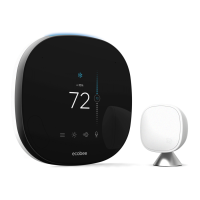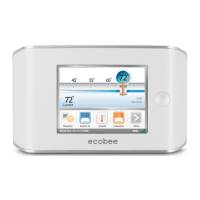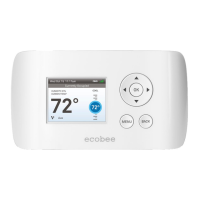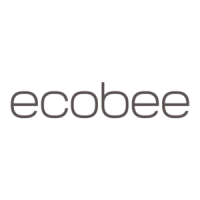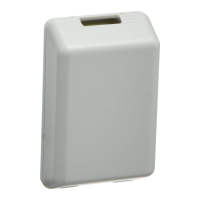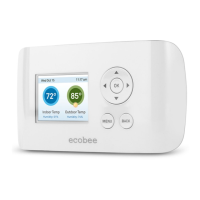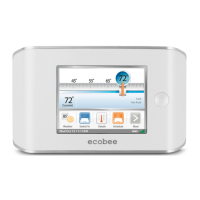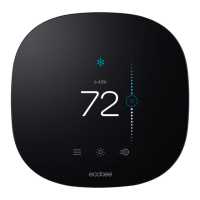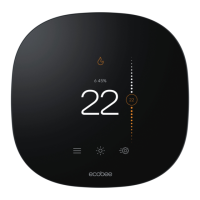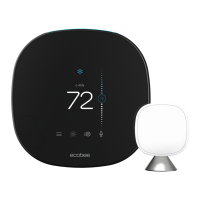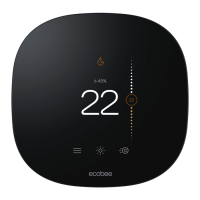
Do you have a question about the Ecobee ecobee3 and is the answer not in the manual?
| Type | Smart Thermostat |
|---|---|
| Energy Reports | Yes |
| Geofencing | Yes |
| Smart Recovery | Yes |
| Warranty | 3 years |
| Compatibility | Works with most HVAC systems |
| Display | Full-color LCD touchscreen |
| Wi-Fi | 802.11 b/g/n |
| Voice Control | Amazon Alexa, Apple HomeKit, Google Assistant |
| Sensors | Temperature, occupancy |
| Power Source | 24VAC |
| Operating Humidity | 5% to 90% RH (non-condensing) |
| Operating Temperature | 32°F to 104°F |
| Storage Temperature | -4°F to 149°F |
| Mobile App | iOS and Android |
| Follow Me | Yes |
Lists the main ecobee3 thermostat unit included in the package.
Details the included remote sensor and its stand for extended temperature monitoring.
Describes the Power Extender Kit (PEK) included for systems without a C-wire.
Mentions the optional trim plate for a cleaner installation.
Refers to the various installation accessories provided in the box.
Guides through configuring the system's wiring setup.
Covers the steps for configuring the HVAC equipment.
Explains how to set user preferences during the initial setup.
Details connecting to Wi-Fi and registering the device.
Identifies temperature display and adjustment features.
Describes controls for system mode and schedule management.
Points out displays for weather, savings, humidity, and motion sensor.
Instructions for activating and positioning remote sensors.
Explains features that optimize comfort based on occupancy.
How to control the fan and switch between heating/cooling modes.
Tips for customizing schedules and managing occupancy states.
Information on controlling ecobee via phone and web portal.
How to view alerts and access the full user guide.
Provides contact numbers, email, and website for support.
Lists the types of HVAC systems compatible with ecobee3.
Description of the 'G' terminal for fan control.
Explains the 'Rc' and 'RH' terminals for power.
Describes the 'O/B' terminal for heat pump reversing valve.
Details the 'Y' and 'W' terminals for heating/cooling stages.
Explains the 'C' terminal for common 24VAC power.
Describes the 'ACC' terminals for accessory devices.
Warning about voltage and current limits for safe operation.
Shows the main thermostat unit and its mounting base.
Displays trim plates and hardware for installation.
Shows the remote sensor and its optional stand.
Displays the PEK and included documentation.
Lists necessary tools and emphasizes reviewing instructions beforehand.
Instructions on how to turn off the HVAC system via breaker.
Guidance on confirming the HVAC system is powered down.
Steps for removing the cover of the existing thermostat.
Critical warning about 110/120V wires and system incompatibility.
Instructions for labeling wires using stickers and taking a picture.
Information on jumper wires and removing the old base.
When to skip PEK, and warnings about HVAC wiring.
Lists minimum wire requirements for PEK installation.
Instructions to ensure HVAC equipment is off and open its control panel.
Instructions for labeling wires and understanding PEK terminals.
Details connections on both PEK cover and base sides.
Instructions for reconnecting wires and mounting the PEK.
Final step of closing the HVAC equipment's control panel.
Reminder for wire management and marking mounting hole locations.
Instructions for attaching the correct size trim plate.
Details on inserting the center piece of the mounting base.
How to use drywall anchors and screws to attach the base.
Guidance on using the built-in level for proper alignment.
Instructions for inserting wires into terminal blocks and ensuring they are secure.
Specifics on R/Rc/Rh connection with PEK and automatic jumpering.
Points to wiring diagrams and attaching the thermostat to the base.
Instructions for powering on the thermostat and following on-screen setup.
Details on configuring equipment, Wi-Fi, and the weekly schedule.
Explains the sensor's function and how to activate it.
What happens when the thermostat detects the sensor and how to troubleshoot connection issues.
Recommends placement areas and warns about distance issues.
How to mount the sensor and avoid problematic locations.
Directs users to the online user guide and mobile app.
Describes menu options for system, schedule, and comfort settings.
Explains remaining menu options like vacation, settings, reminders, and about.
Introduction to diagrams for common HVAC setups.
Points to the website for additional wiring help and tutorials.
Shows wiring for air conditioners and furnaces.
Illustrates connections for two-stage heating and cooling systems.
Shows wiring for heat pump units and air handlers.
Details connections for auxiliary heat stages in heat pump systems.
Shows wiring for air handlers, cooling, and boilers.
Notes on reversing valve connections for heat pumps.
How ecobee controls accessory HVAC devices via ACC terminals.
Need to configure accessory devices and notes on self-powered units.
Specific instruction for connecting the R wire to the Rc terminal on the ecobee3.
Diagram showing PEK connections to HVAC equipment wiring.
Product designed according to RoHS directive standards.
Statement on compliance with FCC rules and interference measures.
Guidelines for RF exposure limits and proximity to antenna.
Compliance statement for Industry Canada license-exempt RSS standards.
Statement on IC radiation exposure limits and installation.
Details the terms and conditions of the 3-year limited warranty.
Instructions for returning defective products for service or replacement.
Lists conditions that void the warranty, such as improper installation or use.
States limitations on ecobee's liability and implied warranties.
Notes warranty expiration and prohibition of modification.
Information on customer rights and how to ask warranty questions.
